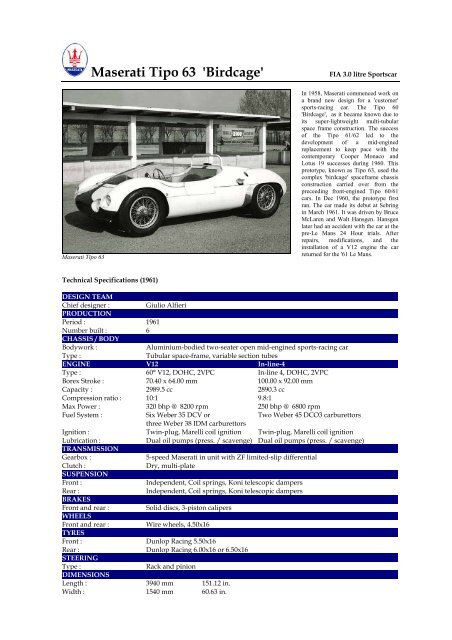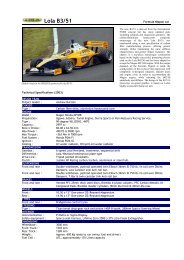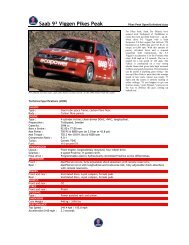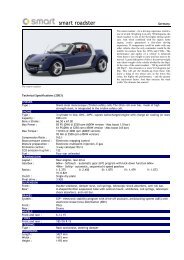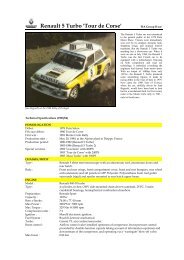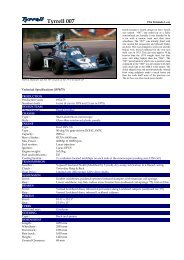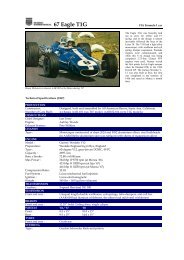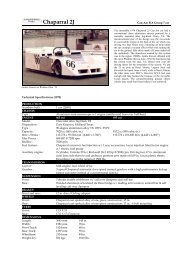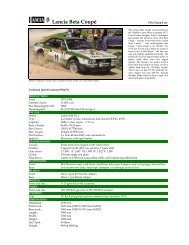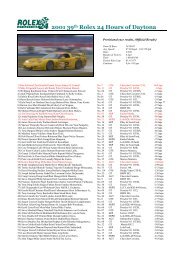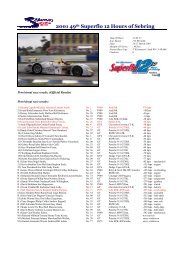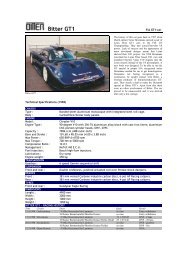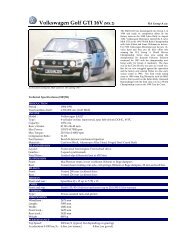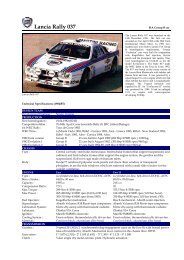1961 Maserati Tipo 63 'Birdcage' - Motorsports Almanac
1961 Maserati Tipo 63 'Birdcage' - Motorsports Almanac
1961 Maserati Tipo 63 'Birdcage' - Motorsports Almanac
Create successful ePaper yourself
Turn your PDF publications into a flip-book with our unique Google optimized e-Paper software.
<strong>Maserati</strong> <strong>Tipo</strong> <strong>63</strong><br />
<strong>Maserati</strong> <strong>Tipo</strong> <strong>63</strong> <strong>'Birdcage'</strong> FIA 3.0 litre Sportscar<br />
Technical Specifications (<strong>1961</strong>)<br />
In 1958, <strong>Maserati</strong> commenced work on<br />
a brand new design for a 'customer'<br />
sports-racing car. The <strong>Tipo</strong> 60<br />
<strong>'Birdcage'</strong>, as it became known due to<br />
its super-lightweight multi-tubular<br />
space frame construction. The success<br />
of the <strong>Tipo</strong> 61/62 led to the<br />
development of a mid-engined<br />
replacement to keep pace with the<br />
contemporary Cooper Monaco and<br />
Lotus 19 successes during 1960. This<br />
prototype, known as <strong>Tipo</strong> <strong>63</strong>, used the<br />
complex 'birdcage' spaceframe chassis<br />
construction carried over from the<br />
preceeding front-engined <strong>Tipo</strong> 60/61<br />
cars. In Dec 1960, the prototype first<br />
ran. The car made its debut at Sebring<br />
in March <strong>1961</strong>. It was driven by Bruce<br />
McLaren and Walt Hansgen. Hansgen<br />
later had an accident with the car at the<br />
pre-Le Mans 24 Hour trials. After<br />
repairs, modifications, and the<br />
installation of a V12 engine the car<br />
returned for the '61 Le Mans.<br />
DESIGN TEAM<br />
Chief designer : Giulio Alfieri<br />
PRODUCTION<br />
Period : <strong>1961</strong><br />
Number built : 6<br />
CHASSIS / BODY<br />
Bodywork : Aluminium-bodied two-seater open mid-engined sports-racing car<br />
Type : Tubular space-frame, variable section tubes<br />
ENGINE V12 In-line-4<br />
Type : 60° V12, DOHC, 2VPC In-line 4, DOHC, 2VPC<br />
Borex Stroke : 70.40 x 64.00 mm 100.00 x 92.00 mm<br />
Capacity : 2989.5 cc 2890.3 cc<br />
Compression ratio : 10:1 9.8:1<br />
Max Power : 320 bhp @ 8200 rpm 250 bhp @ 6800 rpm<br />
Fuel System : Six Weber 35 DCV or Two Weber 45 DCO3 carburettors<br />
three Weber 38 IDM carburettors<br />
Ignition : Twin-plug, Marelli coil ignition Twin-plug, Marelli coil ignition<br />
Lubrication : Dual oil pumps (press. / scavenge) Dual oil pumps (press. / scavenge)<br />
TRANSMISSION<br />
Gearbox : 5-speed <strong>Maserati</strong> in unit with ZF limited-slip differential<br />
Clutch : Dry, multi-plate<br />
SUSPENSION<br />
Front : Independent, Coil springs, Koni telescopic dampers<br />
Rear : Independent, Coil springs, Koni telescopic dampers<br />
BRAKES<br />
Front and rear : Solid discs, 3-piston calipers<br />
WHEELS<br />
Front and rear : Wire wheels, 4.50x16<br />
TYRES<br />
Front : Dunlop Racing 5.50x16<br />
Rear : Dunlop Racing 6.00x16 or 6.50x16<br />
STEERING<br />
Type : Rack and pinion<br />
DIMENSIONS<br />
Length : 3940 mm 151.12 in.<br />
Width : 1540 mm 60.<strong>63</strong> in.
<strong>Maserati</strong>'s chief engineer Giulio Alfieri, work began on what was to become known as the <strong>'Birdcage'</strong> series of<br />
sports-racers <strong>Maserati</strong>'s previous sports car. the big 450S, had not been a total success for it was not the equal<br />
of its competitors on all-round performance and reliability, despite its straight-line speed. Thus a clean sheet<br />
was taken for the design of the new car. Power unit for the first of these models was a four-cylinder, 2-litre unit<br />
based on the older 150S engine. To achieve a low frontal area, the twin overhead camshaft engine was canted<br />
over to the right at an angle of 45° and laid in a very light and strong frame made up of tiny welded steel tubes.<br />
It was probably as near to a true space-frame as had been used in a racing car and its appearance soon earned<br />
it the Birdcage nickname. The gearbox was a five-speed <strong>Maserati</strong> unit with ZF limited slip differential, which<br />
coped admirably with the 195 bhp or so of the engine. Front suspension was independent at the front by coil<br />
springs and dampers, while the rear suspension was by a de Dion axle with coil springs and dampers. Girling<br />
disc brakes of 13ß ins front and 12 ins rear diameter stopped the car admirably. With private owners in mind,<br />
price worked out at around £3,900 and the factory made sure of helping all customers considerably. About six<br />
of the 2-litre <strong>Tipo</strong> 60s were built and the first made its racing debut at Rouen in 1959 for the sports car race<br />
supporting the Grand Prix in the hands of no less than Stirling Moss. Moss took it to a rousing victory despite<br />
the presence of the works Lotus 15s of Innes Ireland and Alan Stacey and almost as soon as the race was over,<br />
work began on the <strong>Tipo</strong> 61, which was, in effect the same car fitted with a 2.8-litre version of the four-cylinder<br />
engine. Two of these were ready in time for the Nassau Speed Week in December and these two <strong>Tipo</strong> 61s were<br />
entered for the Swiss Gaston Andrey and a Lucky Casner-owned version for Carroll Shelby. Of the two,<br />
Andrey's car with streamlined head fairing did well to hold third place before retiring after an accident with a<br />
spinning Lotus Elite. For 1960 Casner was to prove a leading figure in the Birdcage saga for he formed the<br />
Camoradi Team - Casner Motor Racing Division - and bought three more <strong>Tipo</strong> 61s which the factory agreed to<br />
race-prepare. One Camoradi car was readied for the early-season Buenos Aires 1000 Kms for Masten Gregory<br />
/ Dan Gurney. In practice only the Ferrari of Phil Hill was quicker than the Birdcage and Gregory led the race<br />
until he spun and later retired with a broken gearbox. Shortly afterwards, however, Moss made up for that<br />
disappointment by winning the Cuban GP for Camoradi from Pedro Rodriguez in a Ferrari. The Sebring 12<br />
Hours of <strong>1961</strong> turned out to be a strange event as both Ferrari and Porsche withdrew their works cars due to a<br />
dispute with the organisers over fuel contracts, which left three Camoradi and two other Birdcages up against<br />
the rest. However, one Camoradi non-started after an engine blow-up, the Masten Gregory/Carroll Shelby car<br />
blew a piston and the Moss/Gurney car was forced to retire from a big lead with a stripped diff. One of the<br />
private cars, that of John Fitch, crashed, while the other retired with gearbox problems. After this disaster,<br />
Casner demanded modifications and so work was put in to strengthening the connecting rods, gearbox and the<br />
crown-wheel and pinion, all of which had given trouble in the previous races. Before Le Mans, a single<br />
Camoradi <strong>Tipo</strong> 61 was entrusted to local aces Nino Vaccarella and Umberto Maglioli for the Targa Florio and<br />
they did their stuff by leading the race until the penultimate two laps when a stone punctured the petrol tank<br />
and Vaccarella crashed heavily. It was a a very encouraging outing, nevertheless, and although Casner had<br />
been reluctant to enter the cars in races before Le Mans, two 61s went to Nürburgring for Moss/Gurney and<br />
Gregory/Gino Munaron for the championship-qualifying 1000 Kms. Moss/Gurney suffered a broken oil line<br />
early on which lost them some time, but nevertheless they struggled on valiantly through the rain and fog to<br />
record a resounding win, with the sister car in fifth place. For Le Mans itself, Camoradi sent along three white<br />
and blue cars, one of them sporting a special body with huge, enveloping windscreen. However, as at Sebring<br />
they all failed. The newly-bodied car of Gregory and Scarab F1 driver Chuck Daigh worked its way into the<br />
lead, but at the first pitstop would not restart. The starter motor was stripped and eventually the car restarted<br />
in 46th place and worked up to 31st place before succumbing to engine troubles. The sister car of<br />
Scarlatti/Munaron also had starter motor problems and stopped on the Mulsanne Straight with smoke<br />
pouring out of the cockpit and retired, while the car of Casner/Jeffords, which also had starter motor trouble,<br />
retired with a seized gerarbox after being crashed into the bank at Mulsanne and getting sand into its selectors.<br />
To keep up with the design trends a new car, the <strong>Tipo</strong> <strong>63</strong>, was built for the <strong>1961</strong> season. This featured a rearengined<br />
'birdcage' frame with power from a 3-litre version of the four-cylinder engine, and independent<br />
suspension by coil springs at the rear to replace the de Dion axle. Three of these new <strong>Tipo</strong> <strong>63</strong>s appeared at<br />
Sebring, one each from Camoradi, Briggs Cunningham and Count Volpi's Ferrari-breakaway Scuderia<br />
Serenissima. However, all three retired as did the two other Camoradi <strong>Tipo</strong> 61s, leaving victory to Phil Hill's<br />
Ferrari. The <strong>Tipo</strong> <strong>63</strong> was undoubtedly a rapid machine, but its handling left a great deal to be desired as was<br />
shown in the Targa Florio where the <strong>Tipo</strong> <strong>63</strong>s of Scuderia Serenissima for Maglioli/Giorgio Scarlatti and Nino<br />
Vaccarella/Maurice Trintignant were a lowly fourth and fifth respectively. The <strong>Tipo</strong> 60 of Boffa/Todaro<br />
retired with a broken oil line, which was an old Birdcage problem and the sort of occurence that thwarted the<br />
cars from ever showing their real potential. Modifications to the rear suspension geometry of the brutish <strong>Tipo</strong><br />
<strong>63</strong>s were carried out in time for the <strong>1961</strong> Nürburgring 1000 Kms, but although the Birdcage scored its second<br />
consecutive win in this tortuous race, victory was provided by a <strong>Tipo</strong> 61 in the hands of Camoradi Team's<br />
Masten Gregory/Lloyd 'Lucky' Casner, and they only won after Moss in a Porsche had retired with a seized<br />
engine and Phil Hill/Wolfgang von Tripps in a Ferrari had crashed. Thus the big attack was once again saved<br />
for Le Mans. For this classic Cunningham entered no fewer than three cars : a <strong>Tipo</strong> 60 and two new versions of<br />
the <strong>Tipo</strong> <strong>63</strong> (sometimes known as <strong>Tipo</strong> 64s). The chassis were essentially the same, but in the rear lurked a 60<br />
degree 2.9-litre V12 engine. Based on the 1957 Formula 1 unit, and later destined to reappear in F1 in the<br />
Cooper-<strong>Maserati</strong>s, these engines used twin-plug ignition and triple twin-choke Webers. Serenissima also had a<br />
V12 <strong>Tipo</strong> <strong>63</strong>, although this had square engine dimensions of 68mm x 68mm as opposed to the 70mm x 64mm


